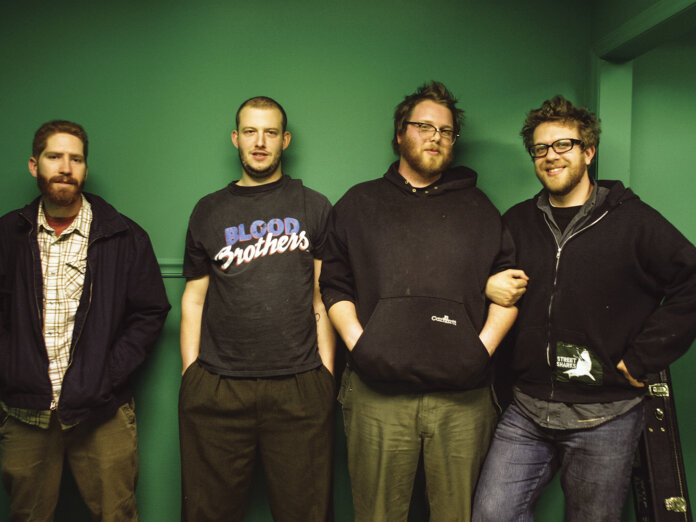On “Handwriting On The Wall”, an a cappella track recorded around the time he was dreaming up Bon Iver, Justin Vernon shouts his head off. He screams and yells and hollers, his performance knowingly too big and too loud for the song. But there’s a point to his histrionics: rather than attempt to convey depth of feeling, Vernon is trying to capture the unique grain of his voice when pushed to such an extreme. It fuzzes out around the edges, becoming unrecognisable as his or even as human. It’s akin to the way he would famously manipulate his voice on 2007’s For Emma, Forever Ago and especially on 2009’s “Blood Bank” EP, except on “Handwriting…” he’s doing it organically rather than digitally.
ORDER NOW: Tom Waits is on the cover of the latest UNCUT
There are many such moments on Epoch, an immense and admiring boxset that collects everything from Vernon’s early band DeYarmond Edison. In these songs can be found the DNA for Bon Iver, but also for nearly all of the roots-leaning indie rock of the past 15 years. DeYarmond Edison weren’t merely a band behind a singing/songwriting frontman, but something closer to the REM model: a democracy where each personality shone through. It’s a supergroup in reverse. In addition to Vernon, the band also included brothers Brad and Phil Cook and percussionist Joe Westerlund. Together, those three released three imaginative albums as Megafaun, including 2009’s excellent Gather Form & Fly. Separately, they’ve been busy as side players and producers, with Phil helming albums for Waxahatchee, Hiss Golden Messenger and Hurray For The Riff Raff, among others.
Listening to Epoch, it’s easy to pick out the origin points for these better-known projects, yet DeYarmond Edison was more than the sum of its players. Together, they created a separate identity, something that is not always present in their subsequent efforts. This set is no mere addendum to their later careers, but a testament to the unique spark between likeminded musicians engaging with – and in some cases reinvigorating – regional music traditions. Their story opens, appropriately, at HORDE Festival, the jam-band version of Lollapalooza, where the primary members first met in 1997. They started playing together during summer band camp, calling themselves Mount Vernon and then DeYarmond Edison (after Vernon’s middle names). In 2005, they moved from Eau Claire to North Carolina, a state where every strain of music, old and new, exists on the same continuum.
The band didn’t really take the Tri-Cities by storm, though. Instead, they were dismissed by some as too earnest, either too accessible or not accessible enough. Epoch doesn’t shy away from these criticisms: “We Can Look Up”, credited to Mount Vernon, presents a sentimental take on roots music, landing a little too close to the self-congratulatory rootsiness of Rusted Root. And on the live track “Set Me Free”, Vernon strains his voice to convey a very conventional – and not especially convincing – soulfulness. Those are the first and last songs on Epoch, which suggests that he and his bandmates were still maturing during this time, still growing into the artists they would become.
In that regard, this set has the trajectory of a thick American novel. It’s a coming-of-age story, as the members of DeYarmond Edison gradually find their footing as players and a command of their own influences. As early as 2002’s Silent Signs, they were pushing – sometimes gently, sometimes violently – at the edges of folk and blues, country and bluegrass, heartland rock and avant-garde drone, boisterous free jazz and beautifully harmonised hymns. The peak might be their five-month residency at the Bickett Gallery in Raleigh in early 2006. Mixing originals like “Phil’s Instrumental” with traditionals like “Step It Up & Go” (the unofficial state song of North Carolina), they deconstruct these styles with wit and imagination, and there’s a high-wire precariousness to the way they let the songs fall apart and then reassemble them in weird new shapes.
That residency serves as the climax of Epoch. DeYarmond Edison called it quits not long after, and Vernon returned to Wisconsin, sequestered himself in a remote cabin and recorded some exquisitely lonely songs. The other members stayed in Raleigh and made music as Megafaun for years before setting off on their own separate careers. There was little animosity between them, as evidenced by the frequency with which they’ve continued to collaborate: at least one of the Cook brothers has played on every Bon Iver album, and Epoch includes tracks from a 2014 reunion show. DeYarmond Edison continue in all but name, although this boxset serves as an exclamation point to their early years together.


